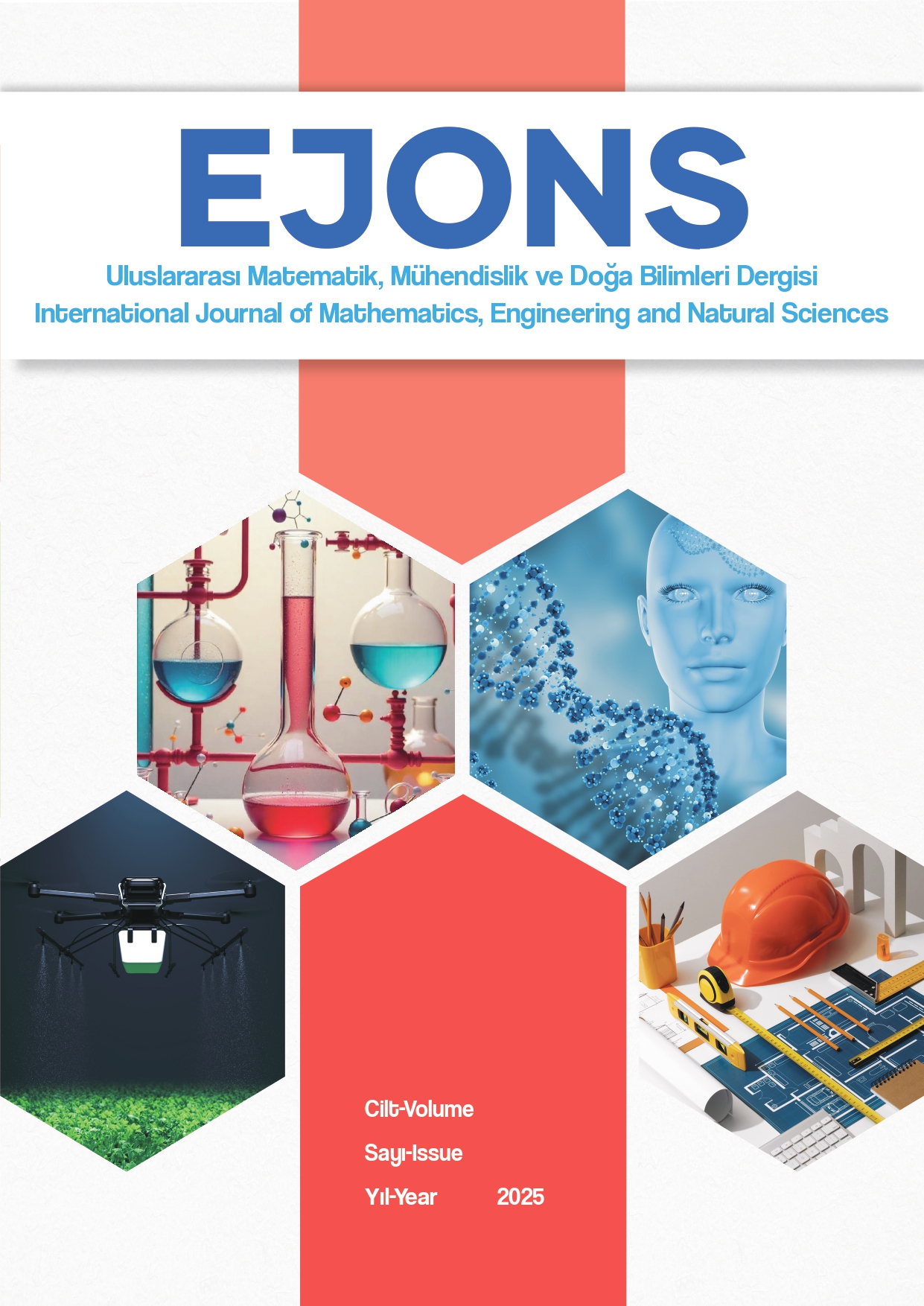V765 Aur ve V638 Vir Örten Çift Yıldızlarının TESS Fotometrik Analizleri
DOI:
https://doi.org/10.5281/zenodo.15048529Anahtar Kelimeler:
Örten Çift Yıldızlar, V765 Aur, V638 Vir , Fotometrik, Veri Analizi, TESSÖzet
Bu çalışmada, V765 Aur ve V638 Vir örten çift yıldız sistemlerinin ışık eğrisi çözümleri ilk defa sunulmuştur. Gözlemsel veri olarak Transiting Exoplanet Survey Satellite (TESS) uydu gözlemleri kullanılmıştır. Işık eğrisi çözümlerinden V765 Aur ve V638 Vir kaynaklarını oluşturan her iki bileşenin de kendi Roche loblarını doldurmadıkları görülmüştür. Çözüm parametreli kullanılarak ele alınan sistemlerin mutlak parametre değerleri tahmin edilmiştir. Buna göre, V765 Aur sistemini oluşturan birinci ve ikinci bileşenlerin kütle ve yarıçap değerleri, sırasıyla, M_1=1.58±0.16 M_⊙, R_1=1.47±0.12 R_⊙ ve M_2=0.46±0.10 M_⊙ , R_2=1.27±0.26 R_⊙ olarak hesaplanmıştır. V638 Vir sisteminin birinci ve ikinci bileşenlerinin kütle ve yarıçap değerleri ise M_1=1.23±0.12 M_⊙, R_1=1.63±0.11〖 R〗_⊙ ve M_2=0.16±0.06 M_⊙, R_2=1.40±0.23 R_⊙ değerlerinde elde edilmiştir.
Referanslar
Applegate, J.H., 1992. A mechanism for orbital period modulation in close binaries. Astrophysical Journal, 385: 621–629.
Bahcall, J.N., Soneira, R.M., 1980. The universe at faint magnitudes, I. Models for the Galaxy and the predicted star counts. Astrophysical Journal, 44: 73-110.
Barberá, R., 1996. AVE (www.astrogea.org/soft/ave/introave.htm) (Erişim Tarihi: 05.01.2025)
Bradstreet, D.H., Steelman, D.P., 2002. AAS 201, 75.02.
Claret, A., 2017. Limb and gravity-darkening coefficients for the TESS satellite at several metallicities, surface gravities, and microturbulent velocities. Astronomy and Astrophysics, 600, A30.
Demircan, O., Kahraman, G., 1991. Stellar Mass / Luminosity and Mass / Radius Relation. Astrophysics and Space Science, 181(2): 313-322.
Drake, A.J., Graham, M.J., Djorgovski, S.G., 2014. The catalina surveys periodic variable star catalog. The Astrophysical Journal Supplement Series, 213(1): 29.
Drilling, J.S., Landolt, A.U., 2000. Allen’s Astrophysical Quantities, (fourth ed.) AIP Press; Springer, New York.
Erdem, A., Doğru, S.S., Soydugan, F., Çiçek, C., Demircan, O., 2010. Period studies of five neglected Algol-type binaries: RW Cet, BO Gem, DG Lac, SW Oph and WY Per. New Astronomy, 15(7): 628-636.
Erdem, A., Öztürk, O., 2014. Non-conservative mass transfers in Algols. Monthly Notices of the Royal Astronomical Society, 441(2): 1166-1176.
Henden, A.A., Levine, S., Terrell, D., Welch, D.L., 2015. APASS - The latest data release. In: AAS Meeting 225. 336, 16.
Irwin, J.B., 1959. Standard light-time curves. Astronomical Journal, 64: 149–155.
Kochanek, C.S., Shappee, B.J., Stanek, K.Z., 2017. The All-Sky Automated Survey for Supernovae (ASAS-SN) Light Curve Server v1.0. Publications of the Astronomical Society of the Pacific, 129(980): 104502.
Lanza, A.F., Rodonó, M., 1999. Orbital period modulation and quadrupole moment changes in magnetically active close binaries. Astronomy and Astrophysics, 349: 887-897.
Lucy, L.B., 1967. Gravity-darkening for stars with convective envelopes. Zeitschrift für Astrophysik, 65: 89-92.
Malkov, O.Y., Oblak, E., Avvakumova, E.A., Torra, J., 2007. A procedure for the classification of eclipsing binaries. Astronomy and Astrophysics, 465(2): 549-556.
Marshall, D.J., Robin, A.C., Reylé, C., Schultheis, M., Picaud, S., 2006. Modelling the Galactic interstellar extinction distribution in three dimensions. Astronomy & Astrophysics, 453(2): 635-651.
Mowlavi, N., Holl, B., Lecoeur-Taïbi, I., 2023. Gaia Data Release 3. The first Gaia catalogue of eclipsing-binary candidates. Astronomy and Astrophysics, 674(A16): 45.
Negu, S.H., Tessema, S.B., 2018. Statistical analysis of Algol-type eclipsing binaries with stable mass transfer. Astronomische Nachrichten, 339(709): 709-717.
Öztürk, O., Erdem, A., 2022. First photometric study of two eclipsing binary star systems: V523 And and V543 And. New Astronomy, 92.
Papageorgiou, A., Catelan, M., Christopoulou, P.E., 2018. An updated catalog of 4680 northern eclipsing binaries with algol-type light-curve morphology in the catalina sky surveys. The Astrophysical Journal Supplement Series, 238(1): 14.
Pecaut, M.J., Mamajek, E.E., 2013. Intrinsic colors, temperatures, and bolometric corrections of pre-main-sequence stars. The Astrophysical Journal, 208(1): 9.
Qian, S.B., Zhang, J., He, J.J., Zhu, L.Y., 2018. Physical properties and evolutionary states of ea-type eclipsing binaries observed by LAMOST. The Astrophysical Journal Supplement Series, 235(1): 12.
Ricker, G.R., Winn, J.N., Vanderspek, R., 2015. Transiting exoplanet survey satellite (TESS). Journal of Astronomical Telescopes, Instruments, and Systems, 1(1): 014003.
Ruciński, S.M., 1969. The proximity effects in close binary systems. II. The bolometric reflection effect for stars with deep convective envelopes. Acta Astronomica, 19: 245–255.
Schlafly, E.F., Finkbeiner, D.P., 2011. Measuring reddening with sloan digital sky Survey stellar spectra and recalibrating SFD. The Astrophysical Journal, 737(2).
Shappee, B.J., Prieto, J.L., Grupe, D., 2014. The man behind the curtain: X-Rays drive the UV through NIR variability in the 2013 active galactic nucleus outburst in NGC 2617. Astrophysical Journal, 788(1).
Tunçel Güçtekin, S., Bilir, S., Karaali, S., Ak, S., Ak, T., Bostancı, Z.F., 2016. Metallicity calibration and photometric parallax estimation: I. UBV photometry. Astrophysics and Space Science, 361(6).
von Zeipel, H., 1924. The radiative equilibrium of a rotating system of gaseous masses. Monthly Notices of the Royal Astronomical Society, 84: 665–683.
Wilson, R.E., 2012. Spotted star light curves with enhanced precision. The Astronomical Journal, 144(3).
Wilson, R.E., Devinney, E.J., 1971. Realization of accurate close-binary light curves: Application to MR Cygni. Astrophysical Journal, 166: 605-619.
İndir
Yayınlanmış
Nasıl Atıf Yapılır
Sayı
Bölüm
Lisans
Telif Hakkı (c) 2025 EJONS Uluslararası Matematik, Mühendislik ve Doğa Bilimleri Dergisi

Bu çalışma Creative Commons Attribution-NonCommercial 4.0 International License ile lisanslanmıştır.


